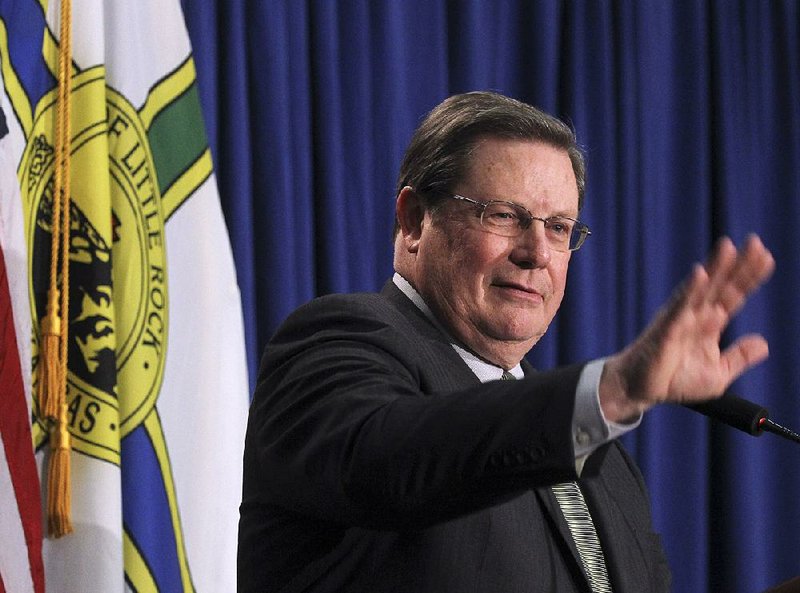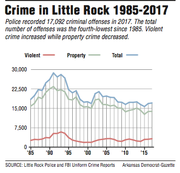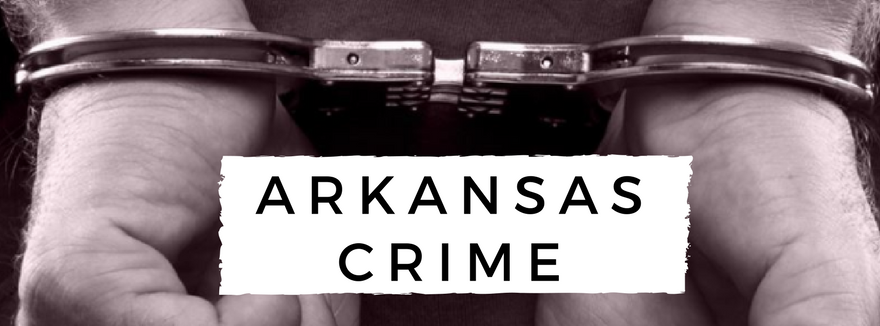Though 2017 was a violent year for Little Rock, police data show crime in the city overall was still low compared with the past three decades.
Police data show the number of criminal offenses rose 1.1 percent last year from the 16,906 offenses recorded in 2016. In 2015, crime in Little Rock was the lowest in at least 36 years. But the 17,092 criminal offenses recorded last year were the fourth-lowest total since 1985, according to department data.
Last year, violent crime rose 6.35 percent, while property crime fell by 0.06 percent. Little Rock police, like most law enforcement agencies, classify homicide, aggravated assaults, robbery and rape as violent offenses. Burglary, larceny, vehicle theft and arson are classified as property crimes.
Little Rock police recorded 3,264 violent offenses last year, the 10th-highest annual total since 1985. Though the number of robberies fell from 659 in 2016 to 496 in 2017, homicide, rape and aggravated assault all rose.
[INTERACTIVE: Search crime reports across city in updated Little Rock crime map]
In 2017, violent crime in Arkansas' capital city was marked by rival gang activity.
In the early hours of July 1, a mass shooting at Power Ultra Lounge left 25 people wounded by gunfire. Three more were injured while fleeing the downtown Little Rock nightclub. Court documents released in January show that witnesses heard an argument and people yelling "Crip" and "Bloods" before the shots.
In February, as part of a larger effort to combat gangs and violent criminals, federal authorities in Little Rock named 49 defendants listed in two complaints and 13 federal indictments.
An Arkansas Democrat-Gazette review of police and court records linked two Little Rock affiliates of those gangs -- Real Hustlers Incorporated and the Wolfe Street Crips -- to shootings that have killed innocent bystanders, wounded children and left homes with bullet holes over the last two years. That includes the April 27 shooting that wounded the 16-year-old daughter of Bilal Johns Muhammad, one of the 49 defendants and a longtime leader in Real Hustlers Incorporated.
Still, data show that crime overall in Little Rock is lower than when gang violence in the city drew national attention during the 1990s. The last three years are among the four lowest for total offenses recorded since 1985.
Police recorded 13,828 property crimes last year, according to department data. The number of burglaries rose from 2,227 in 2016 to 2,310 in 2017, but larceny and motor vehicle theft fell.
Nationally, there was a 0.8 percent decrease in violent crime and a 2.9 percent decrease in property crime in the first six months of 2017, according to the FBI. That figure is based on data reported independently by more than 13,000 law enforcement agencies.
The FBI has not yet released data for the second half of the year. But a study of the country's largest cities by the Brennan Center for Justice found that the decrease in total crime nationwide likely continued to the end of 2017.
According to the analysis, murder rates in some cities remained above 2015 levels, which held true for Little Rock. There were 56 people killed in the city last year, the highest number of homicides in at least a decade, according to data kept by the Arkansas Democrat-Gazette.
The Little Rock Police Department tallied last year's killings at 54 homicides. Unlike the Democrat-Gazette, the Police Department does not include within its yearly total homicides that have been ruled justified. The department also does not include homicides that have been ruled accidental.
Little Rock police data show that the number of nonfatal shooting victims in the city has increased every year since 2014.
Last year, there were 203 nonfatal shooting victims in Little Rock -- a more than 35 percent increase from the 150 victims logged in 2016, according to local police data. The figure accounted for only the number of shooting victims related to first-degree battery.
Little Rock Mayor Mark Stodola said the city has worked to combat the rise in violent crime with initiatives that launched in the second half of 2017, such as Ceasefire Little Rock, which aims to reach people within violent communities and steer them to free services, such as mental health care or career development.
In the midst of a surge of gun violence during the summer of 2017, the Little Rock Police Department announced a plan to increase patrols in high-crime areas, an effort that required officers to work mandatory overtime. The effort, officials have said, played a role in reducing the violence.
In 2018, police had recorded 1,172 violent offenses as of June 11, a 23 percent decrease compared with the 1,529 violent offenses logged through the same date last year.
As of June 11, there had been 20 homicides in the city, three fewer than police had investigated in the same time in 2017.
"If you can move the needle as substantially as we have this first six months to a year, those are extremely significant reductions in crime," Stodola said.
The mayor also noted that most property crimes, particularly larceny and theft, are misdemeanor cases where property valued at less than $1,000 is stolen.
At a news conference in February, Little Rock Police Chief Kenton Buckner credited the department's collaboration with other agencies, including the FBI, for recent arrests of people involved in gangs and violent crime.
"We cannot have sustained success in Little Rock without effective partnerships," Buckner said. "We have to have these collective efforts, and we also need the community to stay engaged in what's going on."
Information for this article was contributed by Ryan Tarinelli of the Arkansas Democrat-Gazette.
Metro on 06/18/2018


